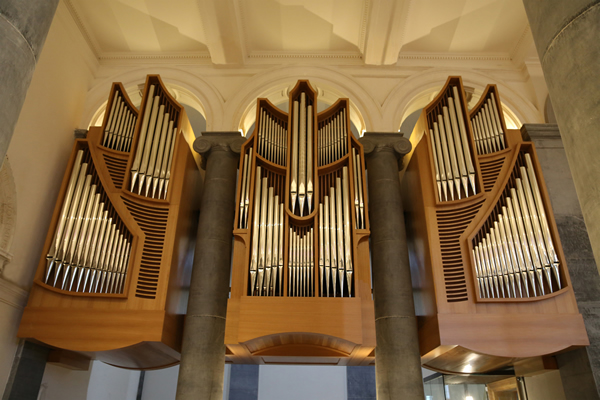The story of St. Mel’s Cathedral in Longford, Ireland, is a story of resurrection, both of its building, after near-total destruction by fire, and of its music.
In the early morning hours of Christmas Day, 2009, a fire started in rear of the building. Firefighters could do very little, since particularly cold weather conditions had left waterlines frozen solid. As a result, the fire burned unchecked for several hours and the entire interior was destroyed, including the pipe organ. On Christmas Day of 2014 the Cathedral, totally restored, was re-opened to the public and a new pipe organ, designed for the space and built by Fratelli Ruffatti, was ready for the occasion.
The installation and tonal finishing of the instrument was a challenge, considering that this work had to take place while the restoration of the cathedral interior was still in progress. Using techniques to protect the organ from construction dust, along with working during odd hours, allowed the Ruffatti crews to complete the instrument in time for the opening event.
The new instrument, of 40 ranks and 2,307 pipes, is located over a large platform between the massive stone columns at the right side of the altar, with a movable three-manual console at floor level right in front. Two of the manual divisions (Choir and Swell) are under expression, and their dynamic range, due to their exclusive design, is remarkable, ranging from nearly a whisper to a roar, which fills the large cathedral space. The tonal resources of the organ ensure the needed versatility for the support of the liturgy and the performance of a wide spectrum of literature. The cathedral’s acoustics make it an ideal location for organ concerts.
The casework design is definitely modern, but symmetrical and in keeping with the cathedral’s interior architecture. The wood chosen by the architects for both the organ case and the console cabinet is American white oak, while the wooden interior parts, including pipes, windchests, and even the walkboards, are made from the highest grade African Sipo mahogany. The shiny façade pipes, as well as the larger interior pipes, are made from 95% tin alloy, which ensures mechanical strength and unsurpassed appearance. The largest of the façade pipes, in the center, is embossed with the traditional “diamond” pattern, a feature which has been in use in Italy since the Renaissance, and which is still made in the Ruffatti pipe shop.
This new instrument is the second in Ireland by the Ruffatti firm, after the three-manual mechanical organ at St Patrick’s College, Maynooth, Ireland’s National Seminary and Pontifical University, installed in 2013.

